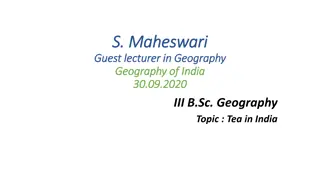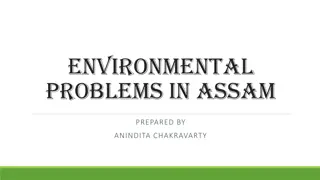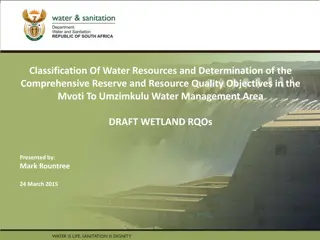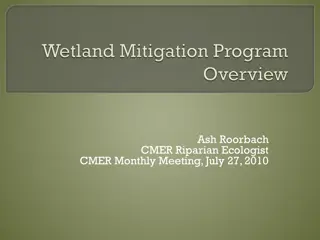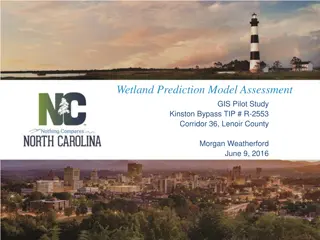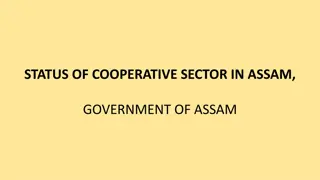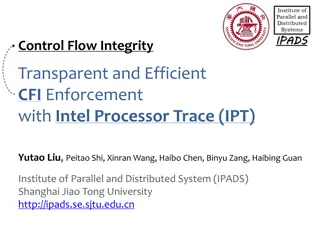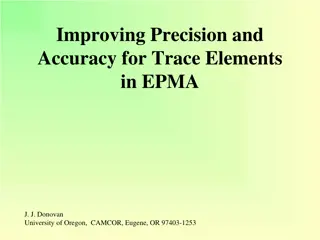Distribution and Occurrence of Trace Elements in Urban Wetland: A Case Study of Deepor Beel, Assam, India
This study focuses on the distribution and occurrence of trace elements and pharmaceutical pollutants in the urban wetland of Deepor Beel in Assam, India. The research investigates the presence of emerging contaminants like pharmaceuticals and personal care products, providing insights into the pollution levels in the wetland ecosystem. Various analytical techniques were employed to quantify physicochemical parameters and trace elements in the water samples collected from the wetland. The findings shed light on the environmental challenges faced by urban wetlands in close proximity to human settlements.
Download Presentation

Please find below an Image/Link to download the presentation.
The content on the website is provided AS IS for your information and personal use only. It may not be sold, licensed, or shared on other websites without obtaining consent from the author.If you encounter any issues during the download, it is possible that the publisher has removed the file from their server.
You are allowed to download the files provided on this website for personal or commercial use, subject to the condition that they are used lawfully. All files are the property of their respective owners.
The content on the website is provided AS IS for your information and personal use only. It may not be sold, licensed, or shared on other websites without obtaining consent from the author.
E N D
Presentation Transcript
Distribution and occurrence of trace elements and pharmaceutical pollutants in an urban wetland : A case study of the Deepor Beel an urban wetland from Assam, India *Parijat Saikia, **Nilotpal Das, *Narayan C Talukdar and ***Manish Kumar * Institute of Advanced Study in Science and Technology, Guwahati, Assam, India ** Indian Institute of Technology Guwahati, Assam, India. ***Department of Earth Sciences Indian Institute of Technology Gandhinagar, India 9/6/2024
State of the art and aim of the study Wetlands around the world at close proximity to human settlement are at risk from encroachment and pollution. Such vulnerable wetlands at close proximity should be classed as urban wetlands . Deepor Beel, a Ramsar wetland, Assam, India is one such wetland. Being an important bird sanctuary it also acts as the sink for various pollutants from the nearby Guwahati city (Roy and Kalita, 2011; Kapil and Bhattacharyya 2013). In recent times the nature of pollutants have changed; better detection methods have also exposed the existence of emergingcontaminants (EM). Most EM can be traced to daily human activities and are generally pharmaceuticals and personal care products (PPCP), moreover these have barely been studied in India (Subedi et al, 2017). The current study explores the recent trends of PPCP concentrations in the lake along with the quantification of physicochemical and trace elements in the lake. 9/6/2024
Setup for the current study ASSAM INDIA Study area Sampling Laboratory (APHA 2005) Major ion analysis Trace elements (Cu, Ni, Zn, Pb, and Cr) PPCPs: Acetaminophen, Theophylline, Carbamazepine Crotamiton PPCPs analyzed by solid phase extraction (SPE) SEM EDS for composition of cores. Statistics and softwares Multivariate analyses (MVA): PCA and HCA using SPSS 21 The Deepor Beel, Assam, India a Ramsar site Location: In the South of bank of the floodplains. In close proximity to Guwahati city Is an Important Sanctuary No. of samples: 5 along the lake Sampling frequency: Twice a year (pre-monsoon completed) Types of samples: samples, surface samples as groundwater samples Brahmaputra Caffeine, core water and Bird well as elemental 9/6/2024
Results and Discussion General trend from surface water (1) Table 1. Descriptives of the different surface water parameters Parameters Site 1 Site 2 Site 3 Site 4 Site 5 pH 6.54 0.25 7.11 32 6.85 0.31 6.6 0.11 6.8 0.41 ORP 211.2 2.10 158.1 1.10 71.5 2.10 160.1 1.30 59.8 1.60 DO 6.16 0.11 5.67 0.16 5.41 0.09 6.01 0.06 5.11 0.12 BOD 2.44 0.07 2.34 0.05 2.78 0.07 3.07 0.11 3.82 0.16 Temp 27.1 0.10 26.57 0.10 27.33 0.12 26.8 0.05 29.2 0.04 EC 121 2.01 214 1.00 122 1.00 227 1.10 446 1.20 TDS 61 1.00 106 0.52 61 0.50 113 0.50 223 1.01 Salinity 0.06 0.01 0.1 0.01 0.06 0.02 0.11 0.01 0.21 0.01 Chloride 41.5 0.50 35.8 0.16 34.1 0.10 49.4 0.5 52.0 1.10 Nitrate 0.11 0.02 0.09 0.01 0.16 0.01 0.28 0.07 0.26 0.09 Sodium 13.24 0.25 12.1 0.15 13.01 0.21 12.3 0.22 12.03 0.32 Potassium 2.03 0.23 2.48 0.09 2.51 0.07 2.64 0.13 4.36 0.15 Calcium 15.56 0.19 14.18 0.11 18.19 0.12 18.88 0.13 22.43 0.21 Sulfate 18.9 0.09 15.46 0.21 15.91 0.43 23.3 1.2 20.31 0.89 Phosphate 1.07 0.49 1.01 0.29 1.19 0.11 1.40 0.4 1.58 0.68 COD 15.3 1.10 11.7 0.93 16.3 0.48 26.4 1.01 34.1 1.11 Cu 0.01 0.00 0.01 0.00 0.01 0.00 0.01 0.00 0.03 0.05 Ni BDL BDL BDL 0.01 0.00 0.03 0.01 Zn 0.03 0.02 0.03 0.01 0.03 0.02 0.05 0.01 0.07 0.02 Pb 0.06 0.01 0.02 0.01 0.03 0.02 0.09 0.04 0.12 0.02 Cr BDL BDL BDL 0.016 0.01 0.034 0.02 Parameters except for ORP (mV), Temp ( C), EC ( S cm-1) and salinity (psu) have units mg L-1 Highest and lowest BOD were detected at site 5 and site 2 respectively. While COD was also highest at site 5. Site 5, an unregulated waste dumping ground, the largest in Guwahati city. While, site 2 is the outlet to Brahmaputra River, which also acts as the inlet during the flooding season. High chloride levels, carried from the city through inlets like Basistha and Bahini rivulets. High levels of Pb at site 5 clearly affirms that it is the most important site in terms of overall contribution to surface water pollution. 9/6/2024
Results and Discussion Concentration of PPCPs Theophylline <LOD Acetaminophen <LOD Caffeine Carbamazepine 3 Crotamiton <LOD Concentration (ng L-1) 54 Detection Limit 20 46 17 0.17 1 PPCPs concentration (ng L-1) LOD Limit of Detection, DL - Detection Limit PPCPs (2) Caffeine and Carbamazepine were found to be higher than the limit of detection (LOD); both are most frequently detected pharmaceutical residues (Zhang et al, 2008). Detection rate of caffeine was highest (100%) among all these pharmaceuticals that were estimated in the beel (lake) area. Carbamazepine which is an antiepileptic drug has been proposed as an anthropogenic marker in water ecosystem. The detection rate of PPCPs in the surface water samples: Caffeine> 9/6/2024 Acetaminophen Theophylline> Carbamazepine> Crotamiton.
Results and Discussion Depth variation between two cores with different pollution levels (3) Site 1 Bird watching point 0-10 cm 20-30 cm Results suggests a Feldspar matrix primarily composed of oxygen and potassium. While the peaks of Cu, Zn and Al were expected. However, we observe arsenic peaks. The matrix data suggests a negligible presence of As which diminishes with depth. 30-40 cm 20-30 cm could also Figure 2. EDS graphs of the core sediment 1: Bird Watching point 9/6/2024
Results and Discussion Depth variation between two cores with different pollution levels (3) Site 2 Kalomoni outlet The matrix is similar to that of core 1. Detectible levels of As were observed in the 0-10 cm and 20-30 cm layers. Most startling presence of Hg. Although present at 0-10 cm, its prominence was greatest at 30-40 percentage). Most like sources are dry electronic wastes. Varying rates of deposition at different times could be the cause of 0-10 cm 20-30 cm 30-40 cm 20-30 cm was the cm (absolute Figure 3. EDS graphs of the core sediment 2: Kalomoni rivulet 9/6/2024 fluctuating
Results and Discussion Identification of key hydrogeochemistry through MVA (4) Principal components analysis yielded three principal displays the anthropogenic inputs into the surface water. b) a) components, dominance and of SO42-, NO3- and COD have high loadings. Hierarchical cluster analysis reveal sewage origin of the trace elements. Sewage, wastewater probably leads to PO4-3, COD, BOD, Ca and NO3- grouping. industrial and domestic Chloride clustered with Pb and SO4-2 could point to grey water, associated processes would bleaching powder, soaps and detergent and corrosion of lead in pipes. be the use of 9/6/2024
New findings and conclusions Results point to an increase in anthropogenic activities across the lake area, most of it being linked to unplanned urbanization of the adjacent Guwahati city and the encroachment of the lake area. Currently PPCPs pose greater threat to the population in the vicinity compared to trace elements. Although high level of Pb at site 5 is a matter of concern. While most of the trace elements are of industrial origin from the Guwahati city, PPCPs have a more dispersed or non-point origin, arising from the city as well the local encroached settlements. SEM EDS reveals that differential rates of deposition could be an important aspect affecting the quality of the sediment. Only surface water analyses was inconclusive as it failed to reveal the Hg pollution at site 2 and the depth stratification in the cores. Further study comparing the sediment-water interaction with the nearby urban area can provide a better insight into wetland contamination status. 9/6/2024
References APHA (American Public Health Association). (2005), Standard methods for the examination of water and wastewater (21st ed.). Washington, D.C. Kapil, N. and Bhattacharyya, K.G. (2013), Spatial, Temporal and Depth Profiles of Trace Metals in an Urban Wetland System: A Case Study with Respect to the Deepor Beel, Ramsar Site 1207, India. Environment and Pollution, 2 (1), http://dx.doi.org/10.5539/ep.v2n1p51 Roy,S. and Kalita, J.C. (2011), Compounds in Water Bodies Around Guwahati City, Assam, India through Gas Chromatography/Mass spectrometry. International Journal of ChemTech Research, 3 (40, 1840-1844 Subedi,B., Balakrishna, K., Joshua,D.J. and Kannan,K. (2017), Mass loading and removal of pharmaceuticals and personal care products including psychoactives, antihypertensives, and antibiotics in two sewage treatment plants in southern India. Chemosphere 167 , 429-437. Zhang, Y., Gei en, S.U. and Gal, C.(2008), Carbamazepine and diclofenac: Removal in wastewater treatment plants and occurrence in water bodies. Chemosphere 73, 1151 1161 9/6/2024


